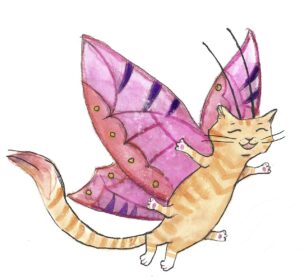Wild Seed, a podcast by Kelly Andrews
Listen:
Read:
I’m Kelly Andrews, and this is the Wild Seed podcast, named for Octavia Butler, whose Positive Obsession essay inspired it.
Ellen Wilmott, one of the first people awarded the Victoria Medal of Honor by the Royal Horticultural Society in 1897, was known for carrying seeds with her, leaving them behind in the gardens she visited. When spiky silver sea holly, actually a kind of thistle, sprang up months later, it became known as Miss Wilmott’s Ghost.
The story is apocryphal, but if evidence supported this story, I might not believe it. In my experience, growing plants from seed to maturity is much harder than scattering them on the ground.
I began gardening when I became a home owner, but I did not begin planting seeds until I became a stay at home mom. At that point, heirloom roses and brand-new hybrids became too expensive, but seeds seemed like a fabulous deal – I could have dozens of plants for the two-dollar price of a pack of seeds, right?
I recently found the receipt from a 2008 mail-order purchase stuck in a garden book. Eight species of seeds, ranging from Tricyrtis hirta ‘Miyazaki’ to Nepeta nervosa ‘Felix.’
Exactly none of those plants is currently growing in my garden. I believe I got one or two catmints and Blazing Stars to bloom, but they have longed since melted away.
Over the next few years, I learned that Jiffy peat pots and a window sill weren’t enough to germinate seeds and grow them into plants sturdy enough to manage the rough and tumble conditions of my garden – packed clay soil, invasive exotic weeds, and excavating squirrels sure they must have buried a black walnut in my potted plants.
I invested in seed starting trays, vermiculite, and full-spectrum lights that imitated the sun. When I couldn’t find what I wanted from large catalogs like Burpee and Park, I branched out to smaller companies like Select and Swallowtail. I ordered hard-to-get geranium seeds from England and learning to stratify seeds in the refrigerator for weeks or months. I started filching ripe seeds from neighborhood gardens.
Now I prefer to grow by seed – those plants are my babies in the way that purchased nursery stock isn’t. I sustained myself during the cold months of winter and – especially while homebound in COVID — watching my green sprouts, checking on the multiple times a day. I took pleasure in the slowness of it all – the time it took to germinate and grow to a seedling, to transfer to a nursery pot or bed to grow on.
A few years ago, a couple things came together: I discovered a one-person seed company based in Bucks County run by a self-described “plant geek.” And I attended a talk on native plantings from the local nursery I rely on (mostly for shrubs these days!). I always knew that native plantings were better, but now my seed passion became far more localized.
When I asked ChatGPT to suggest native plants for my garden, the AI got it wrong. When I asked it why I should plant native plants, it did better. Here’s my summary of what it said.
Native plants are adapted to the local environment, and thus more resilient to weather and climate. They require less water when established in the right setting, and tend to have natural disease resistance, reducing the need to chemicals.
Native plants are part of the natural ecosystem, maintaining biodiversity by providing habitat, food, and shelter for native wildlife, including insects, birds, and mammals, including the human ones. Native plants are part of the cultural heritage and history of a region, including indigenous communities – they provide us humans roots to the places we live.
Why was I modeling my garden after English Victorians like Miss Wilmott and Gertrude Jeckyll? Why was I ordering my seeds from an English company? In fact, the last order from the company I used to rely on was seized and destroyed by the US Dept. of Agriculture, and I’ve learned that the founder of the company has been banned from Nepal for unauthorized plant hunting.
Introduced plants are called invasive or colonizers, and this is a little too on the nose, since I’m of largely English colonial descent. But I can do better. I am not an indigenous person but I can honor and protect the land I stand on by cultivating plants that support its health.
So I plant milkweed for the monarchs, but I care about ugly bugs too. I let the aphids feed on my viburnum and the leafminers feast on my aquilegia, and thus ladybugs, cardinals, and hummingbirds are fed. It’s a system.
I collect seeds from the wild and cultivate them for my garden, even trying to restore a meadow in my parent’s yard after a tornado destroyed most of their trees. (As usual, my dad mowed it as soon as his riding mower fit between the fallen logs).
Once I ripped out the invasive garlic mustard in my shady garden, I identified the plants that took root: Sweet cicely. White avens. Honewort. Enchanter’s nightshade. Now I’ve named them, so they are no longer weeds – they are native garden plants. I have 45 to 50 native species I’ve planted, from stalwarts like echinacea and phlox to lesser known species like cunila and melianthum.
Have the pollinators and birds flocked to their new habitat? Not noticeably. It will take years for many plants to mature. I can wait.
Planting a seed is a hope for tomorrow. Cultivating a plant that takes year to bloom is faith that there will be a future. And planting native species is a small action to ensure that we’ll be there to experience it.

